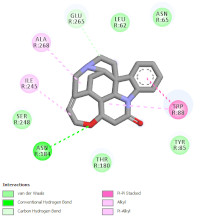Exploring the Molecular Interactions between Volatile Compounds in Coconut Shell Liquid Smoke and Human Bitter Taste TAS2R46 Based on the Molecular Docking and Molecular Dynamics http://www.doi.org/10.26538/tjnpr/v7i12.31
Main Article Content
Abstract
TAS2R46, a bitter taste receptor, is crucial for detecting harmful substances. Understanding its molecular interactions with bitter compounds could help develop bitter taste modulators for the food and pharmaceutical industries. However, such interactions had remained underexplored. A computational method was utilized in this investigation to examine the binding interactions between TAS2R46 and the bitter components of liquid smoke. By utilizing molecular docking and molecular dynamics simulations, one may analyze the modes of binding, the stability of these interactions, and the essential residues at the binding site. The human TAS2R46 protein (PDB ID 7XP6) had been selected for this study. Molecular docking was employed to predict the binding modes and affinity of the liquid smoke’s ligands to the TAS2R46 receptor. Subsequently, molecular dynamics simulations were conducted to analyze the stability and dynamics of the TAS2R46-liquid smoke ligand complexes over a 100 ns timeframe. Our computational findings revealed that the nine teen-reported compounds of liquid smoke could indeed bind to TAS2R46. Delta energy component calculations had indicated the stability of these ligand-receptor complexes, with 1-(2,4,6-trihydroxyphenyl)-ethanone showing the most favorable binding energy. These results provided crucial insights into the molecular basis of bitter taste perception and may have implications for the food industry and drug development. In conclusion, this research bridged a critical knowledge gap by providing a molecular-level understanding of how TAS2R46 interacted with bitter compounds in liquid smoke.
Downloads
Article Details

This work is licensed under a Creative Commons Attribution-NonCommercial-NoDerivatives 4.0 International License.
References
Jelena M, Zorana M. Flavors, colors, and preservatives used in processed cheese. In: Processed Cheese Science and Technology. Elsevier; 2022. P. 125-47.
Xin X, Dell K, Udugama IA, Young BR, Baroutian S. Transforming biomass pyrolysis technologies to produce liquid smoke food flavouring. J Clean Prod 2021;294:125368.
Racioppo A, Speranza B, Pilone V, Stasi A, Mocerino E, Scognamiglio G, et al. Optimizing liquid smoke conditions for the production and preservation of innovative fish products. Food Biosci 2023;53:102712.
Petridis D, Zotos A, Kampouris T, Roumelioti Z. Optimization of a steaming with liquid smoke smoking process of Mediterranean mussel (Mytilus galloprovincialis). Food Sci Technol Int 2013;19(1):59-68.
Hadanu R, Apituley DAN. Volatile Compounds Detected in Coconut Shell Liquid Smoke through Pyrolysis at a Fractioning Temperature of 350-420 C. Makara J Sci Published online 2016:95-100.
Mulyawanti I, Kailaku S, Syah A. Chemical identification of coconut shell liquid smoke. In: Vol 309. IOP Publishing; 2019. P. 012020.
Surboyo MDC, Arundina I, Rahayu RP, Mansur D, Bramantoro T. Potential of distilled liquid smoke derived from coconut (Cocos nucifera L) shell for traumatic ulcer healing in diabetic rats. Eur J Dent 2019;13(02):271-9.
Behrens M, Meyerhof W. Mammalian bitter taste perception. Chemosens Syst Mamm Fishes Insects Published online 2009:77-96.
Zhang Y, Hoon MA, Chandrashekar J, Mueller KL, Cook B, Wu D, Zuker CS, Ryba NJP. Coding of sweet, bitter, and umami tastes: different receptor cells sharing similar signaling pathways. Cell 2003;112(3):293-301.
Ahmad R, Dalziel JE. G protein-coupled receptors in taste physiology and pharmacology. Front Pharmacol 2020;11:587664.
Jaggupilli A, Singh N, Upadhyaya J, Sikarwar AS, Arakawa M, Dakshinamurti S, Bhullar RP, Duan K, Chelikani P. Analysis of the expression of human bitter taste receptors in extraoral tissues. Mol Cell Biochem 2017;426:137-47.
Hu K, Chang R, Zhu Q, Wan J, Tang P, Liu C, et al. Exploring the mechanism of liquid smoke and human taste perception based on the synergy of the electronic tongue, molecular docking, and multiple linear regression. Food Biophys 2020;15:482-94.
Acevedo W, González-Nilo F, Agosin E. Docking and molecular dynamics of steviol glycoside–human bitter receptor interactions. J Agric Food Chem 2016;64(40):7585-96.
Dallakyan S, Olson AJ. Small-molecule library screening by docking with PyRx. Chem Biol Methods Protoc Published online 2015:243-50.
Snyder HD, Kucukkal TG. Computational chemistry activities with Avogadro and ORCA. J Chem Educ 2021;98(4):1335-41.
Jejurikar BL, Rohane SH. Drug designing in discovery studio. Published online 2021.
Xu W, Wu L, Liu S, Liu X, Cao X, Zhou C, Zhang J, Fu Y, Guo Y, Wu Y, Tan Q, Wang L, Liu J, Jiang L, Fan Z, Pei Y, Yu J, Cheng J, Zhao S, Hao X, Liu ZJ, Hua T. Structural basis for strychnine activation of human bitter taste receptor TAS2R46. Science 2022;377(6612):1298-304.
Talmon M, Massara E, Quaregna M, De Battisti M, Boccafoschi F, Lecchi G, Puppo F, Cajandab MAB, Salamone S, Bovio E, Boldorini R, Riva B, Pollastro F, Fresu LG. Bitter taste receptor (TAS2R) 46 in human skeletal muscle: expression and activity. Front Pharmacol 2023;14.
Miceli M, Deriu MA, Grasso G. Toward the design and development of peptidomimetic inhibitors of the Ataxin-1 aggregation pathway. Biophys J 2022;121(23):4679-88.
Nowak S, Di Pizio A, Levit A, Niv MY, Meyerhof W, Behrens M. Reengineering the ligand sensitivity of the broadly tuned human bitter taste receptor TAS2R14. Biochim Biophys Acta BBA-Gen Subj 2018;1862(10):2162-73.
Asnawi A, Nedja M, Febrina E, Purwaniati P. Prediction of a Stable Complex of Compounds in the Ethanol Extract of Celery Leaves (Apium graveolens L.) Function as a VKORC1. Trop J Nat Prod Res. 2023;7(2):2362-70.
Febrina E, Asnawi A. Lead compound discovery using pharmacophore-based models of small-molecule metabolites from human blood as inhibitor cellular entry of SARS-CoV-2. J Pharm Pharmacogn Res 2023;11(5):810-22.
Pan S, Sharma P, Shah SD, Deshpande DA. Bitter taste receptor agonists alter mitochondrial function and induce autophagy in airway smooth muscle cells. Am J Physiol-Lung Cell Mol Physiol 2017;313(1):L154-65.
Cannariato M, Fanunza R, Zizzi EA, Miceli M, Di Benedetto G, Deriu MA, et al. Molecular Biomechanics of the TAS2R46 Bitter Taste Receptor through Network-based Investigation. bioRxiv Published online 2023:2023-11


